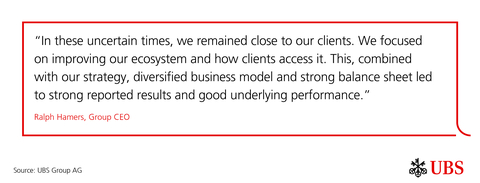UBS: 2Q22 net profit of USD 2.1bn, 18.9% return on CET1 capital (Ad hoc announcement pursuant to Article 53 of the SIX Exchange Regulation Listing Rules)

Ralph Hamers Quote (Graphic:
UBS’s 2Q22 results materials are available at ubs.com/investors
The audio webcast of the earnings call starts at
A definition of each alternative performance measure, the method used to calculate it and the information content are presented under “Alternative performance measures” in the appendix to our 2Q22 report. |
Group highlights
-
We are helping our clients navigate challenging markets
Amidst an acceleration in market declines across equity and fixed income, we focused on being close to our clients and supporting them with advice, liquidity and execution across ourUSD 3.9trn ecosystem. Against this backdrop, Global Wealth Management net new fee-generating assets flows were muted atUSD 0.4bn globally, but they were overUSD 3bn positive in APAC. We sawUSD 12bn of outflows in Asset Management, primarily from equities. With loans of close toUSD 400bn and deposits overUSD 500bn we saw combined net interest income up15% year-on-year for GWM and P&C. Client activity was robust but differentiated across segments as institutional clients remained very active, with10% growth in Global Markets revenues, on the back of high volatility, whereas private investors remained generally on the sidelines. Nonetheless, our clients committedUSD 3.9bn in private markets and investedUSD 4.0bn in separately managed accounts. Momentum also stayed positive in our modular digital mandate offering,My Way , as well as in investment products inSwitzerland , each contributingUSD 0.5bn of inflows. Finally, withUSD 239bn Sustainable Finance invested assets we are more than halfway towards ourUSD 400bn aspiration by 2025.
-
We are executing our strategy to drive sustainable growth and efficiency
We are using technology to improve how clients interact with us and how we work. Our mobile-only retail clients inSwitzerland now represent around a third of our client base, a30% growth versus last year. To support them, we expanded our offering and capabilities withUBS key4. In APAC, we launched Circle One, a platform that will bring the best ofUBS's global ecosystem directly to our clients. We are improving how we manage, change and develop technology, and we are fostering our engineering culture. For instance,60% of our applications are currently on the cloud – half in the public and half in the private cloud. Engineers make up65% of the technology teams that have transitioned to agile, 10 percentage points more than pre-agile. We deployed new AI technology in over 500 applications, and we decommissioned around 300 applications year to date to simplify our tech estate. We achieved this while remaining disciplined on costs, progressing our cost-saving program as planned and investing in our growth initiatives. -
We delivered strong reported results and good underlying performance
2Q22 PBT wasUSD 2,615m (up1% YoY). This included the sale of our stake in a joint venture as announced in 1Q22. Our capital-light business model, proactive risk management and exposure to rising interest rates contributed to the quarter’s good performance. The cost/income ratio was70.6% , an improvement of 1.2 percentage points YoY. Total revenues were broadly flat YoY, while operating expenses decreased by1% . Net profit attributable to shareholders wasUSD 2,108m (up5% YoY), with diluted earnings per share ofUSD 0.61 . Return on CET1 capital was18.9% . The quarter-end CET1 capital ratio was14.2% (guidance: ~13% ) and the CET1 leverage ratio was4.37% (guidance: >3.7% ). We repurchasedUSD 1.6bn of shares in 2Q22 andUSD 3.3bn in the first half of the year, and we expect to repurchase a total of aroundUSD 5bn of shares during 2022, as planned.
“The second quarter was one of the most challenging periods for investors in the last 10 years. Inflation continues to be high, the war in
Institutional clients remained active on the back of high volatility. We supported them with advice and execution while handling very high volumes. At the same time, private clients stayed on the sidelines. We continued to support them with deposits and loan offerings, both of which saw particularly robust year-on-year growth in the
We also grew our ecosystem this quarter for the benefit of our clients. For instance, our offering for separately managed accounts in the US as well as our digital platforms continued to attract inflows. And clients’ demand for and commitments to private markets as a source of diversification and returns increased. This is an area where we see much more potential.
We took further steps to deliver a more personalized, relevant, on-time and seamless experience to our clients. We launched our
Our headline numbers for the quarter were strong. Our underlying performance reflected a good result in an environment with lower asset levels, higher volatility and increasing rates. This shows the strength of our strategy and globally diversified business model.
Heading into the second half of the year, we are well positioned to support clients in an operating environment that remains uncertain.”
Second quarter 2022 performance overview – Group
Group |
2Q22 |
|
|
|
|
1H22 |
|
|
|
|
Targets/guidance |
||||
Return on CET1 capital |
|
|
|
|
|
|
|
|
|
|
15– |
||||
Return on tangible equity |
|
|
|
|
|
|
|
|
|
|
|
||||
Cost/income ratio |
|
|
|
|
|
|
|
|
|
|
70– |
||||
Net profit attributable to shareholders |
|
|
|
|
|
|
|
|
|
|
|
||||
CET1 capital ratio |
|
|
|
|
|
|
|
|
|
|
~ |
||||
CET1 leverage ratio |
|
|
|
|
|
|
|
|
|
|
> |
||||
Tangible book value per share |
|
|
|
|
|
|
|
|
|
|
|
||||
Buybacks |
|
|
|
|
|
|
|
|
|
|
~5bn in FY22 |
Group PBT
PBT was
Second quarter 2022 performance overview – Business Divisions and Group Functions
Global Wealth Management |
2Q22 |
1H22 |
Targets/guidance |
||||||||||||
Profit before tax |
|
|
|
||||||||||||
PBT growth |
( |
( |
10– |
||||||||||||
Invested assets |
|
|
|
||||||||||||
Net new fee-generating assets1 |
|
|
|
||||||||||||
|
|
|
|
||||||||||||
Personal & Corporate Banking |
|
|
|
||||||||||||
Profit before tax |
|
|
|
||||||||||||
Return on attributed equity (CHF) |
|
|
|
||||||||||||
Net new investment products |
|
|
|
||||||||||||
|
|
|
|
||||||||||||
Asset Management |
|
|
|
||||||||||||
Profit before tax |
|
|
|
||||||||||||
Invested assets |
|
|
|
||||||||||||
Net new money excl. money markets |
|
|
|
||||||||||||
|
|
|
|
||||||||||||
|
|
|
|
||||||||||||
Profit before tax |
|
|
|
||||||||||||
Return on attributed equity |
|
|
|
||||||||||||
RWA and LRD vs. Group |
|
|
Up to 1/3 |
Global Wealth Management (GWM) PBT
Total revenues decreased by
Personal & Corporate Banking (P&C) PBT
Total revenues increased by
Asset Management (AM) PBT
Total revenues of
Total revenues decreased by
Group Functions PBT
Extending UBS’s leadership in sustainable finance
Sustainable finance has been a firm-wide priority at
Contributing to a common framework
To increase transparency regarding the environmental impact of financial investments, the Swiss Federal government, together with the financial industry and NGOs, has developed and is now piloting the "Swiss Climate Scores". These are six indicators (greenhouse gas emissions, exposure to fossil fuel activities, global warming potential, verified commitments to net-zero, credible climate stewardship, and management to net-zero) based on existing and internationally established criteria and methods that measure the
From ozone to oxygen
At
Natural capital and biodiversity loss is expressed most directly in SDGs 14 and 15 (“Life below water” and “Life on Land”, respectively). However, it is also linked to others, such as SDG 13 “Climate Action” and SDG 2 “Zero Hunger.” Our commitment to the Principles for Responsible Banking and our participation in the
In a recently published white paper “From ozone to oxygen”, our sustainability experts from across the firm consider how the financial world could contribute to the protection and restoration of our planet’s natural capital including geology, soil, air, water and all living organisms. The paper highlights different areas, including necessary policy innovations, the implementation of frameworks, and the role that investors and the private sector can play in improving our collective response to the impending challenges linked to natural capital.
Entering new partnerships for more impact
As the world shifts toward a lower carbon future,
Information in this news release is presented for |
1 Net new fee-generating assets exclude the effects on fee-generating assets of strategic decisions by |
Our key figures |
|
|
|
|
|
|
|
|
|
|
As of or for the quarter ended |
|
As of or year-to-date |
||||
USD m, except where indicated |
|
|
|
|
|
|
|
|
Group results |
|
|
|
|
|
|
|
|
Total revenues |
|
8,917 |
9,382 |
8,705 |
8,897 |
|
18,299 |
17,574 |
Credit loss expense / (release) |
|
7 |
18 |
(27) |
(80) |
|
25 |
(108) |
Operating expenses |
|
6,295 |
6,634 |
7,003 |
6,384 |
|
12,929 |
12,790 |
Operating profit / (loss) before tax |
|
2,615 |
2,729 |
1,729 |
2,593 |
|
5,344 |
4,891 |
Net profit / (loss) attributable to shareholders |
|
2,108 |
2,136 |
1,348 |
2,006 |
|
4,244 |
3,830 |
Diluted earnings per share (USD)1 |
|
0.61 |
0.61 |
0.38 |
0.55 |
|
1.22 |
1.04 |
Profitability and growth2 |
|
|
|
|
|
|
|
|
Return on equity (%) |
|
14.6 |
14.3 |
8.9 |
13.7 |
|
14.4 |
13.1 |
Return on tangible equity (%) |
|
16.4 |
16.0 |
10.0 |
15.4 |
|
16.2 |
14.7 |
Return on common equity tier 1 capital (%) |
|
18.9 |
19.0 |
11.9 |
19.3 |
|
18.9 |
18.8 |
Return on leverage ratio denominator, gross (%) |
|
3.4 |
3.5 |
3.3 |
3.4 |
|
3.5 |
3.4 |
Cost / income ratio (%) |
|
70.6 |
70.7 |
80.5 |
71.8 |
|
70.7 |
72.8 |
Effective tax rate (%) |
|
19.0 |
21.4 |
21.4 |
22.4 |
|
20.2 |
21.5 |
Net profit growth (%) |
|
5.1 |
17.1 |
(17.6) |
62.8 |
|
10.8 |
35.5 |
Resources2 |
|
|
|
|
|
|
|
|
Total assets |
|
1,113,193 |
1,139,922 |
1,117,182 |
1,086,519 |
|
1,113,193 |
1,086,519 |
Equity attributable to shareholders |
|
56,845 |
58,855 |
60,662 |
58,765 |
|
56,845 |
58,765 |
Common equity tier 1 capital3 |
|
44,798 |
44,593 |
45,281 |
42,583 |
|
44,798 |
42,583 |
Risk-weighted assets3 |
|
315,685 |
312,037 |
302,209 |
293,277 |
|
315,685 |
293,277 |
Common equity tier 1 capital ratio (%)3 |
|
14.2 |
14.3 |
15.0 |
14.5 |
|
14.2 |
14.5 |
Going concern capital ratio (%)3 |
|
19.0 |
19.2 |
20.0 |
20.2 |
|
19.0 |
20.2 |
Total loss-absorbing capacity ratio (%)3 |
|
33.7 |
34.2 |
34.7 |
35.6 |
|
33.7 |
35.6 |
Leverage ratio denominator3 |
|
1,025,422 |
1,072,953 |
1,068,862 |
1,039,939 |
|
1,025,422 |
1,039,939 |
Common equity tier 1 leverage ratio (%)3 |
|
4.37 |
4.16 |
4.24 |
4.09 |
|
4.37 |
4.09 |
Liquidity coverage ratio (%)4 |
|
161 |
160 |
155 |
156 |
|
161 |
156 |
Net stable funding ratio (%)4 |
|
121 |
122 |
119 |
115 |
|
121 |
115 |
Other |
|
|
|
|
|
|
|
|
Invested assets (USD bn)5 |
|
3,912 |
4,380 |
4,596 |
4,485 |
|
3,912 |
4,485 |
Personnel (full-time equivalents) |
|
71,294 |
71,697 |
71,385 |
71,304 |
|
71,294 |
71,304 |
Market capitalization1 |
|
52,475 |
65,775 |
61,230 |
53,218 |
|
52,475 |
53,218 |
Total book value per share (USD)1 |
|
17.45 |
17.57 |
17.84 |
16.90 |
|
17.45 |
16.90 |
Tangible book value per share (USD)1 |
|
15.51 |
15.67 |
15.97 |
15.05 |
|
15.51 |
15.05 |
1 Refer to the “Share information and earnings per share” section of the |
||||||||
Income statement |
|
|
|
|
|
|
|
|
|
|
|||
|
|
For the quarter ended |
|
% change from |
|
Year-to-date |
|||||||
USD m |
|
|
|
|
|
1Q22 |
2Q21 |
|
|
|
|||
Net interest income |
|
1,665 |
1,771 |
1,628 |
|
(6) |
2 |
|
3,436 |
3,241 |
|||
Other net income from financial instruments measured at fair value through profit or loss |
|
1,619 |
2,226 |
1,479 |
|
(27) |
9 |
|
3,845 |
2,787 |
|||
Net fee and commission income |
|
4,774 |
5,353 |
5,557 |
|
(11) |
(14) |
|
10,127 |
11,248 |
|||
Other income |
|
859 |
32 |
233 |
|
|
268 |
|
891 |
297 |
|||
Total revenues |
|
8,917 |
9,382 |
8,897 |
|
(5) |
0 |
|
18,299 |
17,574 |
|||
|
|
|
|
|
|
|
|
|
|
|
|||
Credit loss expense / (release) |
|
7 |
18 |
(80) |
|
(64) |
|
|
25 |
(108) |
|||
|
|
|
|
|
|
|
|
|
|
|
|||
Personnel expenses |
|
4,422 |
4,920 |
4,772 |
|
(10) |
(7) |
|
9,343 |
9,573 |
|||
General and administrative expenses |
|
1,370 |
1,208 |
1,103 |
|
13 |
24 |
|
2,578 |
2,192 |
|||
Depreciation, amortization and impairment of non-financial assets |
|
503 |
506 |
509 |
|
(1) |
(1) |
|
1,009 |
1,026 |
|||
Operating expenses |
|
6,295 |
6,634 |
6,384 |
|
(5) |
(1) |
|
12,929 |
12,790 |
|||
Operating profit / (loss) before tax |
|
2,615 |
2,729 |
2,593 |
|
(4) |
1 |
|
5,344 |
4,891 |
|||
Tax expense / (benefit) |
|
497 |
585 |
581 |
|
(15) |
(15) |
|
1,082 |
1,053 |
|||
Net profit / (loss) |
|
2,118 |
2,144 |
2,012 |
|
(1) |
5 |
|
4,262 |
3,838 |
|||
Net profit / (loss) attributable to non-controlling interests |
|
10 |
8 |
6 |
|
29 |
89 |
|
18 |
9 |
|||
Net profit / (loss) attributable to shareholders |
|
2,108 |
2,136 |
2,006 |
|
(1) |
5 |
|
4,244 |
3,830 |
|||
|
|
|
|
|
|
|
|
|
|
|
|||
Comprehensive income |
|
|
|
|
|
|
|
|
|
|
|||
Total comprehensive income |
|
1,079 |
(72) |
2,602 |
|
|
(59) |
|
1,008 |
2,263 |
|||
Total comprehensive income attributable to non-controlling interests |
|
(17) |
26 |
20 |
|
|
|
|
9 |
10 |
|||
Total comprehensive income attributable to shareholders |
|
1,097 |
(98) |
2,582 |
|
|
(58) |
|
999 |
2,252 |
|||
Comparison between |
|||||||||||||||
|
|
As of or for the quarter ended |
|
As of or for the quarter ended |
|
As of or for the quarter ended |
|||||||||
USD m, except where indicated |
|
|
UBS AG
|
Difference
|
|
|
UBS AG
|
Difference
|
|
|
UBS AG
|
Difference
|
|||
|
|
|
|
|
|
|
|
|
|
|
|
|
|||
Income statement |
|
|
|
|
|
|
|
|
|
|
|
|
|||
Total revenues |
|
8,917 |
9,036 |
(119) |
|
9,382 |
9,494 |
(112) |
|
8,705 |
8,819 |
(114) |
|||
Credit loss expense / (release) |
|
7 |
7 |
0 |
|
18 |
18 |
0 |
|
(27) |
(27) |
0 |
|||
Operating expenses |
|
6,295 |
6,577 |
(282) |
|
6,634 |
6,916 |
(282) |
|
7,003 |
7,227 |
(224) |
|||
Operating profit / (loss) before tax |
|
2,615 |
2,452 |
163 |
|
2,729 |
2,559 |
170 |
|
1,729 |
1,619 |
109 |
|||
of which: Global Wealth Management |
|
1,157 |
1,130 |
27 |
|
1,310 |
1,283 |
27 |
|
563 |
541 |
22 |
|||
of which: Personal & Corporate Banking |
|
413 |
409 |
4 |
|
428 |
420 |
8 |
|
365 |
362 |
3 |
|||
of which: Asset Management |
|
959 |
959 |
0 |
|
174 |
176 |
(2) |
|
334 |
328 |
6 |
|||
of which: |
|
410 |
388 |
22 |
|
929 |
908 |
21 |
|
713 |
710 |
3 |
|||
of which: Group Functions |
|
(324) |
(433) |
110 |
|
(112) |
(227) |
115 |
|
(246) |
(321) |
75 |
|||
Net profit / (loss) |
|
2,118 |
1,974 |
144 |
|
2,144 |
2,012 |
132 |
|
1,359 |
1,266 |
93 |
|||
of which: net profit / (loss) attributable to shareholders |
|
2,108 |
1,964 |
144 |
|
2,136 |
2,004 |
132 |
|
1,348 |
1,255 |
93 |
|||
of which: net profit / (loss) attributable to non-controlling interests |
|
10 |
10 |
0 |
|
8 |
8 |
0 |
|
11 |
11 |
0 |
|||
|
|
|
|
|
|
|
|
|
|
|
|
|
|||
Statement of comprehensive income |
|
|
|
|
|
|
|
|
|
|
|
|
|||
Other comprehensive income |
|
(1,039) |
(1,009) |
(30) |
|
(2,216) |
(2,134) |
(82) |
|
(181) |
(197) |
16 |
|||
of which: attributable to shareholders |
|
(1,011) |
(981) |
(30) |
|
(2,234) |
(2,152) |
(82) |
|
(177) |
(194) |
16 |
|||
of which: attributable to non-controlling interests |
|
(28) |
(28) |
0 |
|
18 |
18 |
0 |
|
(4) |
(4) |
0 |
|||
Total comprehensive income |
|
1,079 |
965 |
114 |
|
(72) |
(121) |
50 |
|
1,178 |
1,069 |
109 |
|||
of which: attributable to shareholders |
|
1,097 |
982 |
114 |
|
(98) |
(148) |
50 |
|
1,171 |
1,062 |
109 |
|||
of which: attributable to non-controlling interests |
|
(17) |
(17) |
0 |
|
26 |
26 |
0 |
|
7 |
7 |
0 |
|||
|
|
|
|
|
|
|
|
|
|
|
|
|
|||
Balance sheet |
|
|
|
|
|
|
|
|
|
|
|
|
|||
Total assets |
|
1,113,193 |
1,112,474 |
719 |
|
1,139,922 |
1,139,876 |
46 |
|
1,117,182 |
1,116,145 |
1,037 |
|||
Total liabilities |
|
1,056,010 |
1,057,390 |
(1,380) |
|
1,080,711 |
1,081,558 |
(847) |
|
1,056,180 |
1,057,702 |
(1,522) |
|||
Total equity |
|
57,184 |
55,085 |
2,099 |
|
59,212 |
58,319 |
893 |
|
61,002 |
58,442 |
2,559 |
|||
of which: equity attributable to shareholders |
|
56,845 |
54,746 |
2,099 |
|
58,855 |
57,962 |
893 |
|
60,662 |
58,102 |
2,559 |
|||
of which: equity attributable to non-controlling interests |
|
339 |
339 |
0 |
|
356 |
356 |
0 |
|
340 |
340 |
0 |
|||
|
|
|
|
|
|
|
|
|
|
|
|
|
|||
Capital information |
|
|
|
|
|
|
|
|
|
|
|
|
|||
Common equity tier 1 capital |
|
44,798 |
42,317 |
2,481 |
|
44,593 |
41,577 |
3,016 |
|
45,281 |
41,594 |
3,687 |
|||
Going concern capital |
|
59,907 |
56,359 |
3,548 |
|
60,053 |
55,956 |
4,097 |
|
60,488 |
55,434 |
5,054 |
|||
Risk-weighted assets |
|
315,685 |
313,448 |
2,238 |
|
312,037 |
309,374 |
2,664 |
|
302,209 |
299,005 |
3,204 |
|||
Common equity tier 1 capital ratio (%) |
|
14.2 |
13.5 |
0.7 |
|
14.3 |
13.4 |
0.9 |
|
15.0 |
13.9 |
1.1 |
|||
Going concern capital ratio (%) |
|
19.0 |
18.0 |
1.0 |
|
19.2 |
18.1 |
1.2 |
|
20.0 |
18.5 |
1.5 |
|||
Total loss-absorbing capacity ratio (%) |
|
33.7 |
32.8 |
0.9 |
|
34.2 |
33.1 |
1.0 |
|
34.7 |
33.3 |
1.3 |
|||
Leverage ratio denominator |
|
1,025,422 |
1,024,811 |
612 |
|
1,072,953 |
1,072,766 |
186 |
|
1,068,862 |
1,067,679 |
1,183 |
|||
Common equity tier 1 leverage ratio (%) |
|
4.37 |
4.13 |
0.24 |
|
4.16 |
3.88 |
0.28 |
|
4.24 |
3.90 |
0.34 |
|||
|
|
|
|
|
|
|
|
|
|||||||
Information about results materials and the earnings call
UBS’s second quarter 2022 report, news release and slide presentation are available from
Time
03:00 US EDT
Audio webcast
The presentation for analysts can be followed live on ubs.com/quarterlyreporting with a simultaneous slide show.
Webcast playback
An audio playback of the results presentation will be made available at ubs.com/investors later in the day.
Cautionary Statement Regarding Forward-Looking Statements
This news release contains statements that constitute “forward-looking statements,” including but not limited to management’s outlook for UBS’s financial performance, statements relating to the anticipated effect of transactions and strategic initiatives on UBS’s business and future development and goals or intentions to achieve climate, sustainability and other social objectives. While these forward-looking statements represent UBS’s judgments, expectations and objectives concerning the matters described, a number of risks, uncertainties and other important factors could cause actual developments and results to differ materially from UBS’s expectations. Russia’s invasion of
Rounding
Numbers presented throughout this news release may not add up precisely to the totals provided in the tables and text. Percentages and percent changes disclosed in text and tables are calculated on the basis of unrounded figures. Absolute changes between reporting periods disclosed in the text, which can be derived from numbers presented in related tables, are calculated on a rounded basis.
Tables
Within tables, blank fields generally indicate non-applicability or that presentation of any content would not be meaningful, or that information is not available as of the relevant date or for the relevant period. Zero values generally indicate that the respective figure is zero on an actual or rounded basis. Values that are zero on a rounded basis can be either negative or positive on an actual basis.
View source version on businesswire.com: https://www.businesswire.com/news/home/20220725005864/en/
Investor contact
Media contact
APAC: +852-297-1 82 00
Source:







